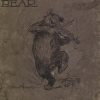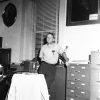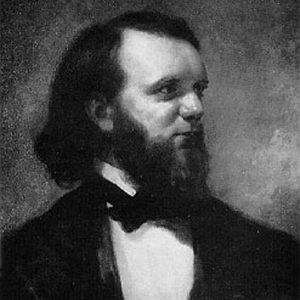calsfoundation@cals.org
The Big Bear of Arkansas
“The Big Bear of Arkansas” by Thomas Bangs Thorpe is a prime example of Southwestern humor. The story and its relations (notably Charles Noland’s “Pete Whetstone’s Bear Hunt” of 1837), along with the presence of bears in the region, helped earn Arkansas the sobriquet of the “Bear State,” as well as adding to the young state’s image as an untamed wilderness.
Thorpe was born on March 1, 1815, in Westfield, Massachusetts, and raised in New York. He earned a living painting portraits, particularly during his years in Louisiana (1838–1854 and in the 1860s). Thorpe also dabbled in politics and investment, both in New York and in Louisiana. His greatest claim to lasting fame was as a writer, publishing six books and more than 150 essays, sketches, and stories. Thorpe died in New York on September 20, 1878, due to complications from Bright’s disease.
“The Big Bear of Arkansas,” possibly based on one of Thorpe’s encounters, was first published on March 27, 1841, in Spirit of the Times. It is not Thorpe’s only sketch on bear hunting (“Scenes on the Mississippi,” “A Grizzly Bear Hunt”), Arkansas (“A Piano in Arkansas,” “The Last from ‘Arkansaw’”), or on bear hunting in Arkansas (“The Devil’s Summer Retreat, in Arkansaw”), but it is certainly his best-known work. “Big Bear” is a colloquial sketch, framed by the narrator’s encounter with Jim Dogget aboard the Mississippi steamboat Invincible. Dogget, the self-proclaimed “Big Bear of Arkansas,” engages in a bit of frontier exaggeration before acceding to the narrator’s request to describe a memorable bear hunt, which he initially summarizes as: “A bear is started, and he is killed.” It is the way Dogget describes his futile pursuit of the beast and its eventual death that made the tale a classic. The story fuses the practice of hunting and the relationship between man and nature on the frontier with the superstitious awe the hunter had for this bear: “But, stranger, I never liked the way I hunted him, and missed him. There is something curious about it, that I never could understand, and I never was satisfied at his giving in so easy at last.…My private opinion is, that that bear was an unhuntable bear, and died when his time come.”
Soon after its initial publication, the story was reprinted in William Trotter Porter’s American Turf Register and continued to grow in popularity, appearing in American and foreign papers and sporting journals. “The Big Bear” was subsequently anthologized in Trotter’s The Big Bear of Arkansas (1845)—in reviewing the book, Edgar Allan Poe found the story dull and forced—and appears in Thorpe’s The Hive of “The Beehunter.”
“The Big Bear” remains one of the best-known stories of the southwestern humor tradition. It is frequently compared to the stories of Mark Twain, such as “The Celebrated Jumping Frog of Calaveras County.” William Faulkner is said to have considered “The Big Bear of Arkansas” a masterpiece and to have modeled some of his work after Thorpe’s story. Historian Bernard DeVoto described an entire category of writing as the “Big Bear School of Southern Humorists” because of this story. Along with Thomas W. Jackson’s book On a Slow Train Through Arkansaw and Sandy Faulkner’s story of the “Arkansas Traveler,” “The Big Bear of Arkansas” is widely regarded as a major factor in the state’s image as an untamed wilderness inhabited by clever but uneducated hillbillies.
For additional information:
Blair, Walter. “The Technique of the Big Bear of Arkansas.” Southwest Review 28 (Summer 1943): 426–435.
Current-Garcia, Eugene. “Thomas Bangs Thorpe and the Literature of the Ante-Bellum Southwestern Frontier.” Louisiana Historical Quarterly 39 (April 1956): 199–222.
Estes, David C. A New Collection of Thomas Bangs Thorpe’s Sketches of the Old Southwest. Baton Rouge: Louisiana State University Press, 1989.
Garner, Stanton. “Thomas Bangs Thorpe in the Gilded Age: Shifty in a New Country.” Mississippi Quarterly 36 (Winter 1982–83): 35–52.
Lemay, J. A. Leo. “The Text, Tradition, and Themes of ‘The Big Bear of Arkansas.’” American Literature 47 (November 1975): 321–342.
Petry, Alice Hall. “The Common Doom: Thorpe’s ‘The Big Bear of Arkansas.’” Southern Quarterly 21 (Winter 1983): 24–31.
Rickels, Milton. Thomas Bangs Thorpe: Humorist of the Old Southwest. BatonRouge: Louisiana State University Press, 1962.
———. “Thomas Bangs Thorpe in the Felicianas.” Louisiana Historical Quarterly 39 (April 1956): 169–197.
Thorpe, Thomas Bangs. “The Big Bear of Arkansas.” Electronic Text Center at the University of Virginia Library. https://twain.lib.virginia.edu/projects/price/bear2000.htm (accessed April 11, 2022).
———. The Hive of “The Bee Hunter,” A Repository of Sketches, Including Particular American Character, Scenery, and Rural Sports. Electronic edition. Documenting the American South. https://docsouth.unc.edu/southlit/thorpe/summary.html#:~:text=Best%20known%20for%20his%20work%20as%20a%20southwestern,and%20Rural%20Sports%20%28D.%20Appleton%20and%20Company%2C%201854%29. (accessed April 11, 2022).
Samuel Pyeatt Menefee
Charlottesville, Virginia
Staff of the Encyclopedia of Arkansas History & Culture
 Arkansaw Bear: A Tale of Fanciful Adventure
Arkansaw Bear: A Tale of Fanciful Adventure Literature and Authors
Literature and Authors Big Bear of Arkansas Illustration
Big Bear of Arkansas Illustration  Thomas B. Thorpe
Thomas B. Thorpe 




Comments
No comments on this entry yet.